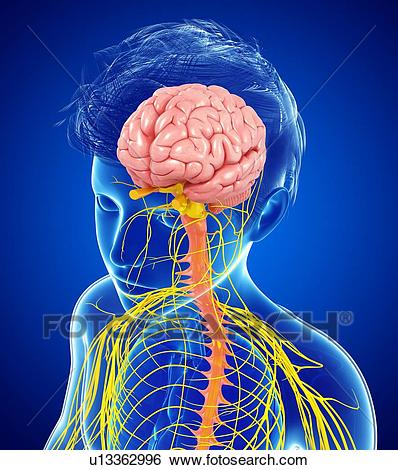The Human Nervous System is composed of three types of neurons: sensory neurons, which collect messages from sensory organs and carry them to the brain and spinal cord; motor neurons, which carry messages from the brain and spinal cord to the body’s muscles; and association neurons, which make connections between incoming and outgoing messages. The central nervous system consists Of the brain and spinal cord. The association neurons in the spinal cord can carry out fast, automatic re- flex actions without involving the brain.
The peripheral nervous system, the portion Of the nervous system that lies outside the brain and spinal cord, is subdivided into the somatic nervous system. controlling voluntary movements and carrying messages from the sense organs, and the autonomic nervous system, governing glands and involuntary muscles. The autonomic nervous system is further subdivided into the sympathetic nervous system, which arouses the body, and the parasympathetic nervous system, which calms the body down.
A typical neuron consists of a cell body, dendrites, which receive messages, and an axon, which transmits messages. In the process Of axonal transmission, messages travel along the surface of the neuron.
The tiny gap between neurons is called a synapse. Messages move from one neuron to the next through the process of synaptic transmission. The firing of a neuron causes a chemical neurotransmitter to cross [he synapse between neurons, thereby increasing or decreasing the likelihood that the next neuron will fire.
Our knowledge of the brain has come from the use of a variety of techniques, in- duding electrical stimulation of the brain, the study of brain-damaged people, brain surgery, analysis of brain waves as recorded on electroencephalograms (EEGs), and various types Of brain scanning, including PET scans and magnetic resonance imaging (MRI).
The human brain consists of four basic sets of structures: the brain stem, cerebellum, limbic system, and cerebral cortex. 10 The brain stem is the most prirnitive part of the brain and is concerned with automatic functions. Among structures found in the brain stem are the medulla, which controls basic physical rhythms and reflexes; the hypothalamus, which monitors such behaviors as eating, drinking, and sleeping; and the reticular formation, which controls the overall activation of the brain.
The cerebellum, located behind the brain stem, is involved in balance and coordination.
The limbic system, including such structures as the amygdala and the hippo- Campus, is found only in mammals. It appears to be involved in emotional expression.
The cerebral cortex contains centers for sight, hearing, taste, smell, and touch. It is the site of thought, intelligence, and memory. The cerebral cortex is divided into four functionally separate lobes: frontal, parietal, occidental, and temporal. A narrow strip of cortex at the top of the head controls the sensory and motor responses of the body.
Evidence of the specialization of brain function has often come from studies of brain-damaged patients. Damage to different sires in the cortex causes aphasia, or language breakdown. For example, patients with damage to Broca’s area in the frontal lobe have difficulty articulating words and have faulty grammar.
Patients with damage to Wernicke’s area in the left temporal lobe Often choose inappropriate words. The new brain-scanning techniques are rapidly increasing our knowledge of the specialization of brain function.
The cerebral cortex is divided into two halves, the left and right cerebral hemispheres.
In right-handed people, the left hemisphere has primary control over verbal abilities; the right hemisphere has primary control over such nonverbal skills as recognition of complex visual patterns and expression and recognition of emotion. The right side of the brain controls the left side of the body, and vice versa. In left-handed people, the different functions of the two hemispheres are shared more evenly.
The hemispheres are connected by a band Of fibers called the corpus callous. When this band is severed, the individual in effect has two separate brains.

